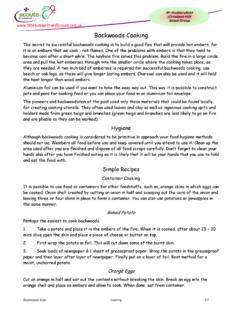Transcription of Instructions for conducting and recording audio …
1 GCSE English Language (8700) Spoken Language Endorsement audio -visual evidence guidance Instructions for conducting and recording audio -visual evidence for the Spoken Language Endorsement audio -visual recordings For the assessment of the Spoken Language, schools and colleges are required to submit audio - visual recordings of the presentations of a sample of their students. Each school/college is required to provide audio -visual recordings of the presentations of a sample of students. Usin g their knowledge of students likely performance, schools should select the sample following the guidance shown in the table below.
2 No. of students at the school/college No. of students wh ose presentations must be recorded Minimum no. of students at each grade (D, M, P) 30 or fewer All students 10 Over 30 30 10 The sample should be representative of the teaching groups within the school or college. Schools/colleges are recommended to record slightly more than the minimum number at each grade to allow for students whose performance is awarded a higher or lower grade than the school or college had anticipated. For full details of what is required, please refer to the Appendix in the JCQ document on the conduct of non-examination assessments.
3 Schools/colleges are advised to plan in advance where and when the audio -visual recording sessions will take place. Spoken Language assessments can take place at any time during the t wo-year course so long as the sample of audio -visual recordings is submitted by the deadline given by the individual awarding body. audio -visual recordings should be conducted in an organised and structured way. Each recording must contain the following information: component number (8700) centre number candidate number candidate name (forename and surname) outcome of the spoken presentation.
4 800_12345_0001_Joe Bloggs _ Pass AQA Ed ucatio n (AQA) is a re gistered ch arity (number 1073334) and a co mp any limite d by g uarantee registered in England and Wale s (n umber 3644723). Our registered ad dre s s is AQA, D evas Street, Manchester M15 6 EX. Choose option 2 of 3 Note that each piece of information is separated by an underscore ( _ ), and spaces are preserved in candidate names. Please do not use underscores to separate candidate first and last names. The recording of each student s presentation, including questions and feedback from the audience, must be complete and unedited.
5 Any proceedings at the beginning or end which are not part of the assessment should not be recorded or should be edited out. All students should identify themselves and their school or college at the start of the recording by either holding an A4 written sign to the camera or by stating their name and centre. Schools/colleges can make the recordings on any audio -visual recording device that they have available, including on webcams, video recorders and iPads. Each recording must be of a good quality; the image of the student must be stable and clear and any participants in the assessment, including the student and audience members, must be clearly audible.
6 It is the school/college responsibility to ensure that the image and sound on each recording is of a good quality. Awarding bodies will not be able to verify the school/college assessment of Spoken language if the recordings submitted are of poor quality. To ensure good quality recordings, schools/colleges are advised to: to check the quality of recording equipment in advance of conducting the recorded assessments stabilise the recording equipment position the recording equipment from an audience perspective so that the student and any support materials used in the presentation, such as PowerPoint or notes.
7 Are in view position the recording equipment close enough to the student and audience members so that speech is clear and audible remove any objects which may obstruct the image and/or sound of the recording conduct recordings in a quiet environment to reduce background noise. The preferred format for recordings is .mp4, as it is the most widely supported format across media players. However, recordings in .wmv, .mpeg/.mpg, .avi, .asf and .mov are also acceptable. Schools/colleges should check that recordings made by their devices are playable on VideoLAN VLC media player to ensure that recordings will be playable by verifiers.
8 It s important that recordings are of sufficient quality for verifiers to identify students and assess their performance. However, schools/colleges should make efforts to avoid submitting excessively large files. It is not necessary for the contents of any slide presentation to be visible in the video. This can be submitted as a separate file. Some ways of minimising file size are given below. Record high-definition video at a resolution of 720p (1280x720) rather than 1080p (1920x1080). A resolution of 720p will result in files less than half the size of 1080p, usually with no significant impact on quality.
9 If your video recorder permits other quality settings to be changed in addition to the resolution, it is often possible to significantly reduce file sizes while not significantly impacting quality. Choose option 3 of 3 If your video recorder provides more limited quality settings, it is often possible to significantly reduce the size of video files after recording wit h no significant impact on quality using free software such as HandBrake ( ). Such software will also be able to save the output in the preferred .mp4 format, even if the original recording wa s made in another format.
10 Schools/colleges may choose to film each student in the sample in individual sessions or may film more than one student in a session. Schools/colleges that choose to record multiple students during the same session must ensure that the start and end of each individual assessment is clearly identified on the recording . The Spoken Language assessment should be conducted as a formal exam session where possible. Mobile phones are not permitted and no one should enter or leave the room during presentations. The audience, although they may respond as a normal audience, must not distract the presenter.


















